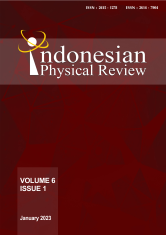MORPHOLOGYCAL, ELEMENTAL CONTENT, AND PHYSICAL PROPERTIES OF CLEANED CLINOPTITOLITE ZEOLITE (10X) USING SONICATION AND MICROWAVE
DOI:
10.29303/ipr.v6i1.204Downloads
Abstract
This research was conducted to determine the morphology, elemental content and physical properties of the zeolite samples before and after cleaning. The characterization used in this study is the Scanning Electron Microscope-Energy Dispersive X-Ray (SEM-EDX). Based on the results of SEM-EDX, it was shown that the 200 mesh zeolite sample and the zeolite that passed the filter had a non-spherical particle shape and no visible pores on the surface, while the microwave zeolite sample had an aggregate shape and visible pores on the particle surface which were very clear. In addition, in the 200 mesh zeolite sample, filtered zeolite and microwave zeolite each had an Al content percentage of 1.64%, 3.18 and 3.80% and a Si content of 7.58%, 15.15% and 18 .38%.
Keywords:
Zeolite clinoptitolite microwave alumina-silicaReferences
M. Moshoeshoe, M. Silas Nadiye-Tabbiruka, and V. Obuseng, “A Review of the Chemistry, Structure, Properties and Applications of Zeolites,†Am. J. Mater. Sci., vol. 2017, no. 5, pp. 196–221, 2017, doi: 10.5923/j.materials.20170705.12.
Y. Setiawan and F. W. Mahatmanti, “Preparasi dan Karakterisasi Nanozeolit dari Zeolit Alam Gunungkidul dengan Metode Top-Down,†Indones. J. Chem. Sci., vol. 7, no. 1, pp. 43–49, 2018.
A. Mastinu et al., “Zeolite clinoptilolite: Therapeutic virtues of an ancient mineral,†Molecules, vol. 24, no. 8, 2019, doi: 10.3390/molecules24081517.
N. M. Orjioke, “Synthesis and Characterization of Zeolite and Its Application in Adsorption of Nickel from Aqueous Solution,†J. Pharm. Chem. Biol. Sci., vol. 3, no. 4, pp. 592–600, 2016, [Online]. Available: https://www.jpcbs.info/2015_3_4_19_Orjioke.pdf
S. K. Pavelić, J. S. Medica, D. Gumbarević, A. Filošević, N. Pržulj, and K. Pavelić, “Critical review on zeolite clinoptilolite safety and medical applications in vivo,†Front. Pharmacol., vol. 9, no. NOV, pp. 1–15, 2018, doi: 10.3389/fphar.2018.01350.
R. Kaviani, “Investigation of the Application of Zeolites in the Adsorption Mechanism Investigation of the Application of Zeolites in the Adsorption Mechanism,†J. Chem. Lett., vol. 3, no. May, 2022, doi: 10.22034/JCHEMLETT.2022.338590.1068.
M. Rilyanti, E. Gita Silviana, B. Buhani, K. D. Pandiangan, and N. Luh Gede Ratna Juliasih, “Sintesis Dan Karakterisasi Zeolit Mordenit (Mor) Pori Hirarki Berbasis Silika Abu Ampas Tebu,†Anal. Environ. Chem., vol. 5, no. 02, pp. 178–191, 2020, doi: 10.23960/aec.v5.i2.2020.p178-191.
M. Krol, “Natural vs. Synthetic Zeolites,†Crystals, vol. 10, no. 622, pp. 1–8, 2020.
A. Khaleque et al., “Zeolite synthesis from low-cost materials and environmental applications: A review,†Environ. Adv., vol. 2, no. August, 2020, doi: 10.1016/j.envadv.2020.100019.
G. Hu et al., “Recent developments and challenges in zeolite-based composite photocatalysts for environmental applications,†Chem. Eng. J., vol. 417, no. February, p. 129209, 2021, doi: 10.1016/j.cej.2021.129209.
N. Jiang, R. Shang, S. G. J. Heijman, and L. C. Rietveld, “High-silica zeolites for adsorption of organic micro-pollutants in water treatment: A review,†Water Res., vol. 144, pp. 145–161, 2018, doi: 10.1016/j.watres.2018.07.017.
C. Finocchiaro et al., “In situ and micro-Raman spectroscopy for the identification of natural Sicilian zeolites,†J. Raman Spectrosc., vol. 53, no. 3, pp. 525–539, 2022, doi: 10.1002/jrs.6278.
Y. Akdeniz and S. Ülkü, “Microwave effect on ion-exchange and structure of clinoptilolite,†J. Porous Mater., vol. 14, no. 1, pp. 55–60, 2007, doi: 10.1007/s10934-006-9008-z.
E. M. Dewi, . Suwardi, D. T. Suryaningtyas, and S. Anwar, “Utilization of Natural Zeolites as Cu (Ii) and Zn (Ii) Adsorbent,†J. Tanah Trop. (Journal Trop. Soils), vol. 21, no. 3, p. 153, 2016, doi: 10.5400/jts.v21i3.2203.
B. Bogdanov, D. Georgiev, K. Angelova, I. Markovska, and Y. Hristov, “Natural Zeolites : Clinoptitolite Review,†Int. Sci. Conf. 4th - 5th June 2009, Stara Zagor. Bulg. “Economics Soc. Dev. Base Knowledge,†vol. VII, no. June, pp. 1–5, 2009.
S. W. Pratomo, F. W. Mahatmanti, and T. Sulistyaningsih, “Pemanfaatan Zeolit Alam Teraktivasi H3PO4 sebagai Adsorben Ion Logam Cd(II) dalam Larutan,†Indones. J. Chem. Sci., vol. 6, no. 2, pp. 161–167, 2017.
W. W. Purwanto, S. S. Paramitha, D. T. Kimia, F. Teknik, and U. Indonesia, “Ultrasonic and Microwave Application for Purifying Carbon Nanotubes Synthesized By Methane Decomposition Method,†J. Purifikasi, vol. 12, no. 1, pp. 75–82, 2011.
M. R. Silva et al., “Graphene-oxide loading on natural zeolite particles for enhancement of adsorption properties,†RSC Adv., vol. 10, no. 8, pp. 4589–4597, 2020, doi: 10.1039/c9ra00572b.
A. M. Fuadi, M. Musthofa, K. Harismah, Haryanto, and N. Hidayati, “Pemakaian Microwave untuk Optimasi Pembuatan Zeolit Sintetis dari Abu Sekam Padi,†Simp. Nas. Teknol. Terap., no. ISSN 2339-028X, pp. 1–5, 2013.
H. I. Umam and T. Hernawati, “Pengaruh Pemanasan Microwave terhadap Morfologi dan Luas Permukaan Material Zeolite NaX,†J. Ind. Manuf., vol. 3, no. 1, pp. 11–14, 2018, doi: 10.31000/jim.v3i1.614.
M. Mahardika, H. Abral, A. Kasim, S. Arief, and M. Asrofi, “FTIR and Moisture Absorption of Yam Bean Starch Biocomposites with Yam Bean (Pachyrhizus erosus) Bagasse Fibers as Reinforcement,†J. ILMU DASAR, vol. 19, no. 2, p. 93, 2018, doi: 10.19184/jid.v19i2.7255.
License

This work is licensed under a Creative Commons Attribution-NonCommercial-ShareAlike 4.0 International License.
Authors who publish with Indonesian Physical Review Journal, agree to the following terms:
- Authors retain copyright and grant the journal right of first publication with the work simultaneously licensed under a Creative Commons Attribution-ShareAlike 4.0 International Licence (CC BY SA-4.0). This license allows authors to use all articles, data sets, graphics, and appendices in data mining applications, search engines, web sites, blogs, and other platforms by providing an appropriate reference. The journal allows the author(s) to hold the copyright without restrictions and will retain publishing rights without restrictions.
- Authors are able to enter into separate, additional contractual arrangements for the non-exclusive distribution of the journal's published version of the work (e.g., post it to an institutional repository or publish it in a book), with an acknowledgment of its initial publication in Indonesian Physical Review Journal.
- Authors are permitted and encouraged to post their work online (e.g., in institutional repositories or on their website) prior to and during the submission process, as it can lead to productive exchanges, as well as earlier and greater citation of published work (See The Effect of Open Access).





